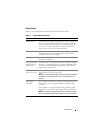
Introduction 7
Cluster Nodes
Table 1-1 lists the hardware requirements for the cluster nodes.
Table 1-1. Cluster Node Requirements
Component Minimum Requirement
Cluster nodes A minimum of two identical PowerEdge servers are required.
The maximum number of nodes that is supported depends
on the variant of the Windows Server operating system used
in your cluster, and on the physical topology in which the
storage system and nodes are interconnected.
RAM The variant of the Windows Server operating system that is
installed on your cluster nodes determines the minimum
required amount of system RAM.
iSCSI Initiator Install the iSCSI port driver, Initiator Service, and Software
Initiator on each node.
Network Interface
Cards (NICs) for
iSCSI access
Two iSCSI NICs or two iSCSI NIC ports per node. Configure
the NICs on separate PCI buses to improve availability and
performance. TCP/IP Offload Engine (TOE) NICs are also
supported for iSCSI traffic.
NICs (public and
private networks)
At least two NICs: one NIC for the public network and
another NIC for the private network.
NOTE: It is recommended that the NICs on each public network
are identical, and that the NICs on each private network are
identical.
Internal disk
controller
One controller connected to at least two internal hard drives
for each node. Use any supported RAID controller or disk
controller.
Two hard drives are required for mirroring (RAID 1) and at
least three are required for disk striping with parity (RAID 5).
NOTE: It is strongly recommended that you use hardware-based
RAID or software-based disk-fault tolerance for the internal drives.


















